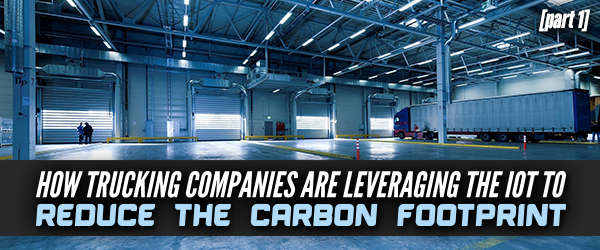
How Trucking Companies are Leveraging the IoT to Reduce the Carbon Footprint – Part I
The Internet of Things (IoT) is driving revolutions and evolutions across a wide range of industries. IoT refers to the “web” of devices that are now being created as more and more devices are plugged into the Internet. With IoT, gathering data is easy, and it’s now possible to remotely respond to changing circumstances on the fly.
For cities, IoT could prove to be an immense boon. Let’s get straight to the point: many local governments are coming under pressure to rein in costs while increasing services, pushing many to see the value in becoming IoT ready. Creating an IoT enabled smart city will take an investment. However, the cost savings can, in the long run, significantly outweigh the setup costs.
Consider fleet management. Many cities have fleets of waste management trucks and other vehicles in constant motion. Fuel and labor costs for operating such fleets can add up quickly. Fortunately, smart cities and IoT can leverage sensors, data, and communication technologies to reduce fuel consumption by up to 10% and to save costs elsewhere. As a result, smart cities can reduce the impact on the environment and greenhouse gas emissions all while saving money.
How IoT Can Connect Drivers, Trash, Vehicles, and Customers
Increase Visibility
While evaluating a fleet’s everyday operations in real-time is immensely beneficial, it can be challenging. Monitoring driver behavior is also difficult for fleet managers. Should an accident occur or a situation arises, fleet managers are often left flat-footed in their response. IoT can be used to monitor safety records, operating costs, and various risk factors.
IoT-connected smart displays enable real-time supervision. Onboard sensors will increase the visibility of both the truck and the truck driver. An IoT smart panel display will also act as an interface and communication portal between the central office, the truck, and the truck driver.
Keep Drivers Focused
Driver focus can be a major liability for any fleet. However, IoT will help drivers stay on task and will empower fleet managers to provide oversight. Multiple video and audio feeds can be integrated. Using IoT, all of this data can be displayed in real time, which allows for flexible and easy interfacing with the vehicle’s control system, as well as bilateral communication.
Smart displays also provide most if not all of the information that drivers need. This way, they don’t have to dig around on smartphones and through other devices while on the route. Instead, they can rely on the smart display while also staying focused on the road.
Meanwhile, onboard monitoring will raise flags if needed. Hard breaking, speeding, and other behaviors can be monitored and reported. Should an accident occur, the onboard cameras and other sensors will capture what happened.
Enhanced but Easy Data Collection
Traditionally, data has been recorded manually by drivers. However, such manual recording can result in inaccurate data due to human error. Because IoT sensors can gather data that is more accurate and reliable, fleet managers can identify problems more quickly and will empower management when needed.
Much of the data will be collected automatically and collected centrally. This will allow the city to build a macro view of the fleet in real time. Sensors can also monitor for maintenance issues. Proactive fleet management will allow the city to maximize its fleet capacities.
A More Eco-friendly Fleet
Imagine a green fleet that reduces fuel consumption by 10% or more. With IoT, it’s obtainable. Consider simple idling. Due to idle time, a vehicle fleet can waste up to 1 billion gallons of diesel annually, which results in more than 10 million tons of carbon dioxide pouring into the air.
With IoT connected onboard computer sensors, fleet managers can monitor for idling and reduce the behavior. Data and IoT communication will create other opportunities to reduce waste and inefficiency. Fleet managers will be able to monitor and react to data and developments in real time.
Optimize Every Route
Another way to make fleets more environmentally friendly is to optimize routes. Construction, accidents, traffic flow, and other factors can result in sub-optimal routes. However, with IoT, a fleet manager can monitor the entire fleet and change routes on the fly, and ultimately minimize distance traveled, turns, time stuck at stop lights, and other driver inefficiencies.
The result of these environmental measures is reduced fuel costs and more efficient operations. With cities under pressure to conserve resources and eliminate waste, smart fleets could become a tremendous asset.
Smart Cities and Smart Fleets Are the Future and IoT Will Make ‘Smart’ Possible
IoT will be a boon for city management. Fleet management, in particular, offers an excellent way for cities to cut costs and to reduce the impact on the environment. In our next blog post, we will dig more deeply into the specific technologies and methods used to reduce costs and increase efficiency. While smart cities may sound high-minded, in practice it’s pragmatically and technologically grounded.

